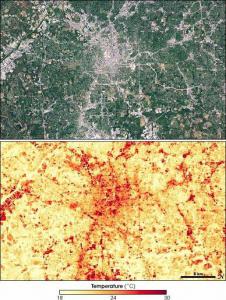Heat Islands
Cool Science
Urban Heat Islands
The summer urban heat island (UHI) effect is a daytime elevation in the outdoor urban air temperature that results in part from the replacement of trees and other vegetation with buildings, roads and other heat-absorbing infrastructure.

CAUSES
The properties of urban roofs and pavements, as well as human activity, contribute to the formation of summer [no-glossary]urban heat islands[/no-glossary]:
- Urban surface properties. Roofs and pavements can constitute about 60% of the surface area of a U.S. city. These surfaces are typically dark in color and thus absorb at least 80% of sunlight, causing them to get warmer than lighter colored surfaces.1 These warm roofs and pavements then emit heat and make the outside air warmer.
- Human activity. Air conditioning, manufacturing, transportation, and other human activities discharge heat into our urban environments.
CONSEQUENCES
Urban heat islands can negatively affect the urban community and the environment.
- Increased energy use. Warm temperatures in cities increase the need for air conditioning (A/C) to cool buildings. This elevated demand can strain the electrical grid on a hot summer afternoon, making it more susceptible to brown-outs and black-outs.
- Impaired air quality. Warmer air accelerates the formation of smog (ozone) from airborne pollutants like nitrogen oxides and volatile organic compounds. Elevated demand for cooling energy in the form of A/C use can also increase the emission of air pollutants and greenhouse gases from fossil-fuel power plants.
- Illness. Higher air temperatures and lower air quality can aggravate heat-related and respiratory illnesses, and also reduce productivity.
Notes:
1 Akbari H, Menon S, Rosenfeld A. 2009. Global cooling: increasing world-wide urban albedos to offset CO2. Climatic Change, 94 (3-4), 275-286.
Related Links:
RELATED PUBLICATIONS
2017
Pomerantz, Melvin. "Are Cooler Surfaces a Cost-Effect Mitigation of Urban Heat Islands?." Urban Climate (2017). LBNL-2001095.
![]() PDF (540.32 KB)
PDF (540.32 KB)
2015
Pomerantz, Melvin, Pablo J Rosado, and Ronnen M Levinson. "A Simple Tool for Estimating City-Wide Annual Electrical Energy Savings from Cooler Surfaces." Urban Climate 14.2 (2015) 315 - 325. LBNL-184804.
![]() PDF (1.22 MB)
PDF (1.22 MB)
2014
Sproul, Julian, Man-Pun Wan, Benjamin H Mandel, and Arthur H Rosenfeld. "Economic Comparison of White, Green, and Black Flat Roofs in the United States." Energy and Buildings 71 (2014) 20-27.
2012
Levinson, Ronnen M. "The Case for Cool Roofs." 2012.
![]() PDF (205.7 KB)
PDF (205.7 KB)
2011
Menon, Surabi, and Ronnen M Levinson. "Cool roofs and global cooling: a response to Jacobson & Ten Hoeve (2011)." 2011.
![]() PDF (164.37 KB)
PDF (164.37 KB)
2005
Akbari, Hashem, Ronnen M Levinson, William A Miller, and Paul H Berdahl. "Potentials of urban heat island mitigation." Proceedings of the 1st International Passive and Low Energy Cooling for the Built Evironment 2005: 11.
2003
Akbari, Hashem, Leanna S Rose, and Haider Taha. "Analyzing the land cover of an urban environment using high-resolution orthophotos." Landscape and Urban Planning 63.1 (2003) 1-14.
2002
Taha, Haider, Hillel Hammer, and Hashem Akbari. Meteorological and air quality impacts of increased urban albedo and vegetative cover in the greater Toronto Area, Canada. Lawrence Berkeley National Laboratory, 2002. LBNL-49210.
2000
Akbari, Hashem, and Arthur H Rosenfeld. "Cool communities." Macmillan Encyclopedia of Energy 1 (2000) 305-8. LBL-44129.
Taha, Haider, Alan K Meier, Weijun Gao, and Toshio Ojima. "Mitigation of urban heat islands: meteorology, energy, and airquality impacts." Journal of Architecture, Planning and Environmental Engineering 529 (2000) 69-76.
1999
Taha, Haider. "Modifying a mesoscale meteorological model to better incorporate urban heat storage: a bulk-parameterization approach." Journal of Applied Meteorology 38 (1999) 466-473.
1998
Rosenfeld, Arthur H, Hashem Akbari, Joseph J Romm, and Melvin Pomerantz. "Cool communities: strategies for heat island mitigation and smog reduction." Energy and Buildings 28 (1998) 51-62.
Akbari, Hashem, and Sarah E Bretz. "Cool systems for hot cities." Professional Roofing 32-35 (1998) 1-5. LBL-43814.
1996
Rosenfeld, Arthur H, Joseph J Romm, Hashem Akbari, Melvin Pomerantz, and Haider Taha. "Policies to reduce heat islands: Magnitudes of benefits and incentives to achieve them." 1996 ACEEE Summer Study on Energy Efficiency in Buildings. 18th ed. Vol. 9. Asilomar Conference Grounds, Pacific Grove, CA, 1996. 177-186. LBL-38679.
![]() PDF (1.82 MB)
PDF (1.82 MB)
1990
Huang, Yu Joe, Susan Davis, and Hashem Akbari. "A guidebook for the control of summer heat islands." 1990 ACEEE Summer Study on Energy Efficiency in Buildings 1990: 79-85. LBL-29224.
1988
Taha, Haider, Hashem Akbari, Arthur H Rosenfeld, and Yu Joe Huang. "Residential cooling loads and the urban heat island—the effects of albedo." Building and Environment 23 (1988) 271-283.